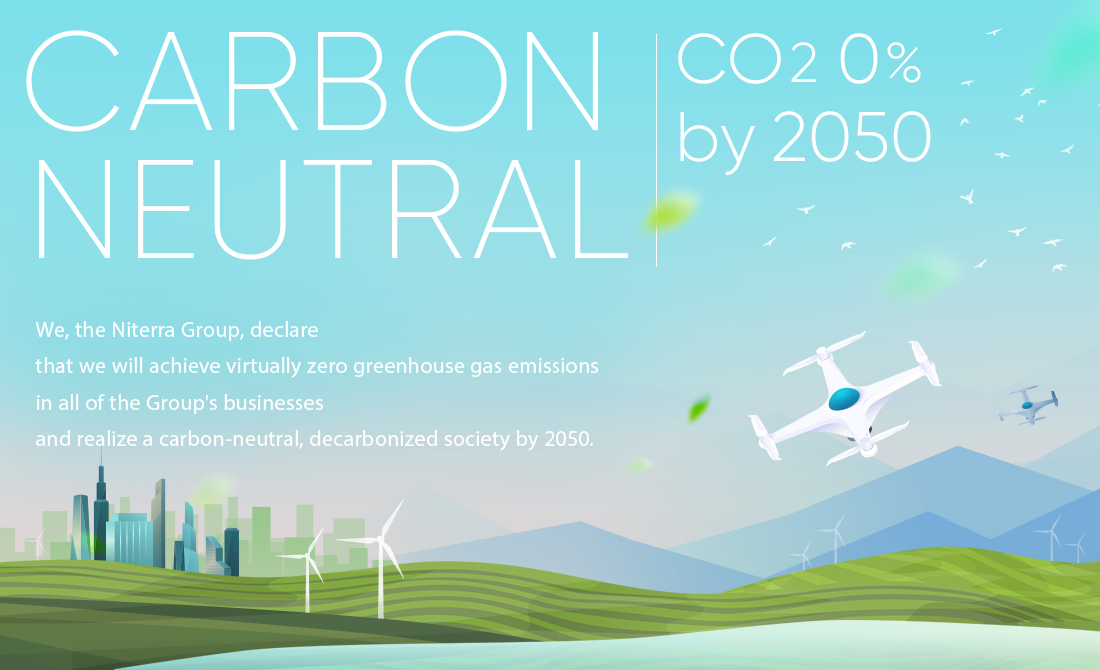
Reducing greenhouse gas emissions to mitigate climate change is an urgent, global-scale challenge, and it is also a priority issue for the Niterra Group. In particular, as a corporate group engaged in manufacturing, we believe that reducing CO2 emissions from our business activities is a responsibility that our Group must fulfill.
On the premise of aiming to achieve carbon neutrality by 2050, we have declared in “Eco Vision 2030” a target of reducing CO2 emissions (Scope 1 and 2) by 30% by FY2030 compared to FY2018 levels. We will also strive to reduce CO2 emissions across the supply chain and product lifecycle, aiming to achieve the target of reducing CO2 emissions (Scope 3) by 30% by FY2030 compared to FY2018 levels. We also set a target at the end of FY2024 to reduce CO2 emissions (Scope 1 and 2) by 71.4% by FY2035 compared to FY2018 levels.
Toward achieving these targets, we will implement various measures under four key plans, “Plan A: Energy Conservation,” “Plan B: Manufacturing and Work Style Improvement,” “Plan C: Energy Creation,” and “Plan D: Procurement/Certificates,” thereby promoting both systematic CO2 emissions reduction and economic growth.
In the future, we will establish a “carbon cycle” system, and in conjunction with this, we will work to utilize hydrogen. Through these efforts, we will promote the beneficial use of CO2 both inside and outside the group and contribute to resolving climate change issues while aiming for a net-zero CO2 emissions within the group.
| Item | Target |
|---|---|
| Scopes 1 and 2 |
71.4% reduction by FY 2035 (compared to that of FY 2018)*1 30% reduction by FY 2030 (compared to that of FY 2018)*2
|
We have created a roadmap to achieve a 30% reduction in Scope 1 and 2 CO2 emissions by 2030. The roadmap mainly consists of four key plans -- “Plan A: Energy Conservation,” “Plan B: Manufacturing and Work Style Improvement,” “Plan C: Energy Creation,” and “Plan D: Procurement/Certificates.” We will implement various measures under these four plans to promote both systematic reduction of CO2 emissions and economic growth.

When introducing production equipment, we create a checklist for energy-efficient design and conduct checks using it. For existing production equipment and ancillary equipment, we are working on equipment improvement to reduce standby energy consumption during holidays and at night.
In addition, we carry out periodic inspections and maintenance to prevent air leaks and other energy loss due to aging equipment.
In addition to switching to LED lighting and turning off lights and PCs during breaks, we encourage “Cool Biz” wear in summer and “Warm Biz” in winter and appropriately control temperature, humidity, and ventilation to save energy.
Green space has been installed on the rooftop at a part of the Komaki Plant for the purpose of expanding green space and energy-saving effects.
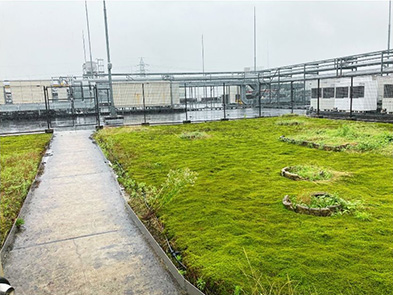
We review manufacturing conditions (profiles) on an as-needed basis to avoid using excessive energy for production. The amount of CO2 emissions of each internal business company is visualized on an internal dashboard, and daily improvement activities are being carried out at each site to ensure production is as energy efficient as possible. Our Group works as one to promote energy saving activities by sharing successful improvement cases across the Group.
We enhance the use of renewable energy, including solar energy, hydropower, and geothermal energy.
The following are the main locations where facilities for renewable energy are currently being installed. We will continue to strategically install these facilities in the future.
| Renewable energy | Country | Name of plants and companies | Nominal generating capacity(kw) | |
|---|---|---|---|---|
| Solar energy | Japan | Niterra Co., Ltd. | Komaki | 620 |
| SparkTec WKS CO., LTD. | Nino | 2,000 | ||
| SparkTec WKS CO., LTD. | Satsuma | 422 | ||
| NTK CERATEC CO., LTD. | Sendai | 422 | ||
| India | Niterra India Private Limited | - | 567 | |
| China | Niterra(Changshu)Co., Ltd. | - | 500 | |
| Niterra(Shanghai)Co., Ltd. | - | 200 | ||
| Thailand | Niterra ASIA Co., Ltd. | - | 3,637 | |
| Niterra (Thailand) Co., Ltd. | - | 1,679 | ||
| Siam Niterra Co., Ltd. | - | 389 | ||
| Brasil | Niterra do Brasil Ltda | - | 3,064 | |
| Geothermal energy | Japan | SparkTec WKS CO., LTD. | Okusa | - |
| Hydropower | Japan | Niterra Co., Ltd. | Komaki | - |
See for actual power generation, please refer to the Sustainability Data.
The Komaki plant already has a compact fuel cell system with a rated power output of 20 kW and a hybrid power system using a fuel cell with a rated power output of 250 kW. We will continue to take on the challenge of reducing CO2 emissions through the creation of clean energy by studying the possibility of installing various energy devices, such as pure hydrogen fuel cell systems and storage batteries.

The headquarters and Spark Tech WKS’s Satsuma Plant and Satsuma Electrode Plant use CO2-free electricity for 100% of their power needs. The Komaki Plant and NTK CERATEC partially use CO2-free electricity.
We also plan to systematically implement CO2-free electricity while curbing power consumption, mainly through energy-saving activities.
In order to contribute to the realization of a carbon-neutral society, we are developing methanation-related technologies (hydrogen production technology that applies ceramic solid electrolytes and CO2 recovery technology that applies oxygen concentrator technology).
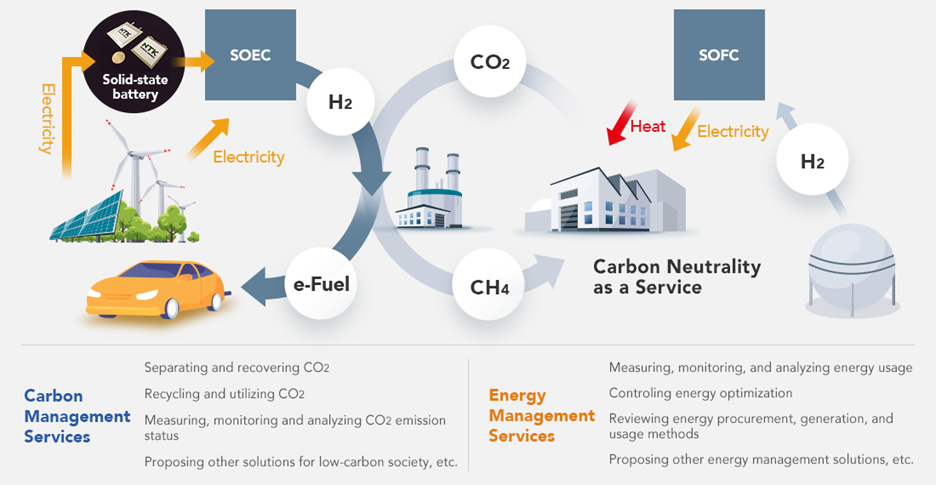
As part of efforts to further reduce CO2 emissions, the CO2 emission reduction rate is included as one of the performance indicators for the performance-linked stock compensation plan for directors (excluding directors who are members of the audit and supervisory committee and outside directors) and executive officers (excluding employed officers).
To reduce emissions in Scopes 1 and 2 with the aim of achieving carbon neutrality, we take the following awareness-raising measures: internal carbon pricing, internal carbon taxation, and an internal environmental fund.
For internal carbon pricing, our group has decided to collect 10,000 yen per ton of CO2. Internal carbon taxation is a system under which fees are collected from departments, including internal business companies and group companies, depending on the amount of their CO2 emissions. This system is expected to further raise awareness of and accelerate CO2 emissions reduction.
The internal environmental fund is a system to appropriate the fees collected through internal carbon taxation for capital investment as a grant to reduce CO2 emissions. For example, in FY 2023, we provided a grant for a solar power generation unit to the Ise Plant and the Nakatsugawa Plant of CERAMIC SENSOR. When introducing equipment, we make a comprehensive decision at a corporate management committee after conducting an environmental assessment not only of CO2 emissions, but also of water, energy, and other overall environmental factors.
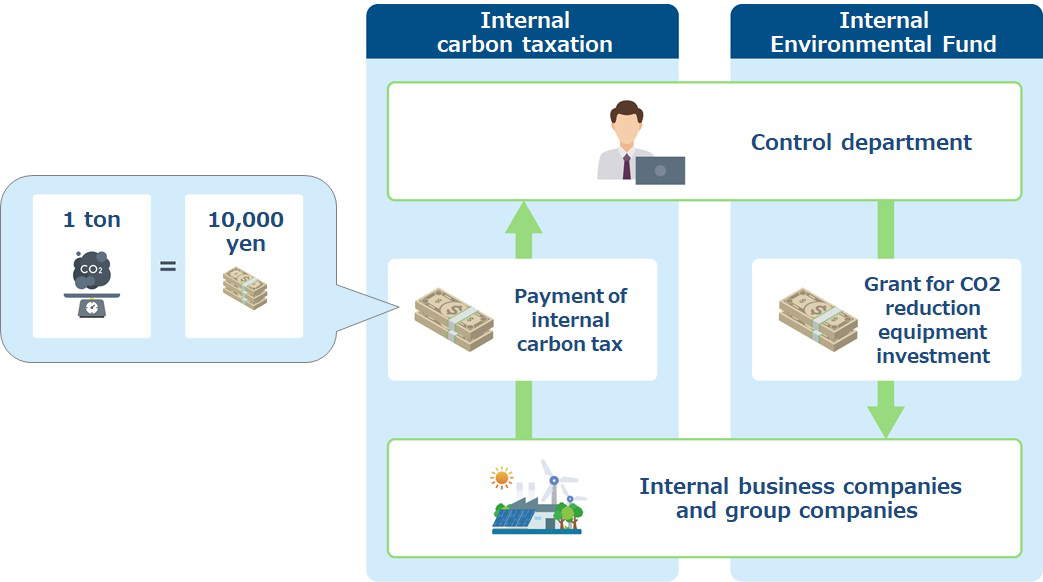
Under this initiative, our company receives from Chubu Electric Power Miraiz a supply of electricity with added environmental value, which is derived from surplus electricity* generated from solar power systems at employees’ homes, and uses the supplied electricity at the Komaki Plant. In addition, employees who provide environmental value of surplus electricity will be given incentives through Chubu Electric Power Miraiz.
Through this initiative, we will promote carbon neutrality together with our employees.
As part of our energy creation initiatives and in addition to our existing efforts, we will begin exploring a PPA scheme designed for businesses that our employees, business partners, and product users (factories and stores) can join. This initiative aims to reduce CO₂ emissions not only within our group but also across the wider community. As the service provider, our company will install solar power generation systems at local factories and stores, supplying the generated electricity directly to their users. Any surplus electricity generated by these solar power systems will be utilized by our company. In the future, we plan to effectively utilize this generated electricity for hydrogen production and its subsequent use, thereby contributing to the realization of a carbon-recycling society.
Through this comprehensive initiative, we are committed to promoting community-wide carbon neutrality.
| Item | Target |
|---|---|
| Scope 3:Category 1 “Purchased goods and services” Category 4 “Upstream transportation and distribution” (in part) Category 11 “Use of sold products” |
30% reduction by FY 2030 (compared to that of FY 2018) |
Scope 3 emissions are indirect greenhouse gas emissions excluding those in Scopes 1 and 2 (emissions from other companies associated with our business operations), divided into 15 categories.
Our emissions in Category 1 “Purchased goods and services,” Category 4 “Upstream transportation and distribution,” and Category 11 “Use of sold products” make up 97.6% of our total Scope 3 emissions. Therefore, we work on reducing CO2 emissions by setting a target to be achieved by FY 2030 in terms of these three categories.
For Category 1 emissions, through the CSR and Sustainability Procurement Guidelines, we ask our business partners to set a target for reducing CO2 emissions and work toward achieving the target. We also provide our business partners with support when needed.
For Category 4 emissions, as a specified consigner stipulated in the Act on the Rational Use of Energy, we work to reduce CO2 emissions associated with transportation by reducing shipping distances through the restructuring/consolidation of plants and the reconsideration of waste-disposal service vendors.
For Category 11 emissions, which account for the largest portion of total Scope 3 emissions, we work on, for example, designing products to improve their energy efficiency while being used.
To promote CSR and sustainability initiatives throughout our supply chain, we have issued the “CSR and Sustainability Procurement Guidelines” and distributed them to our suppliers.
These Guidelines stipulate what we expect our suppliers to comply with. They also outline our response to climate change, and in the Guidelines, we ask our suppliers to set CO2 reduction targets and take measures to achieve them. We also ask our suppliers to disseminate these Guidelines to their suppliers and encourage their implementation.
In order to understand CO2 emissions related to our company at our suppliers, we have been conducting surveys of CO2 emissions related to products for our company. We also provide necessary support to suppliers upon request depending on the amount of their CO2 emissions.
We hold seminars for our suppliers to introduce the risks of climate change and our efforts to reduce CO2 emissions as case studies.
Products manufactured at our plants are transported by land to the nearest port and shipped by sea worldwide.
Products manufactured at the Satsuma Plant were previously shipped overland to Nagoya Port and Hakata Port, but we have additionally started using Satsumasendai Port, which is located close to the Satsuma Plant. By transporting some of the products manufactured at the Satsuma Plant to the Satsumasendai Port, we aim to achieve more efficient transportation and reduce CO2 emissions from land transport.
By reviewing logistics bases, we expect to achieve an annual CO2 emission reduction of approximately 42 tons.
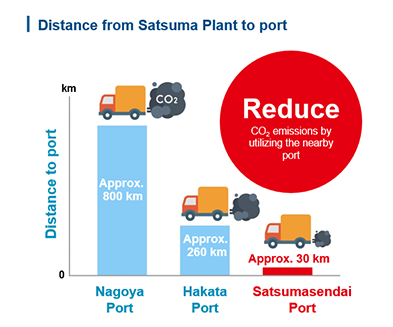
Our Group also contributes to CO2 reduction in its own products.
Among our products, we certify products with particularly high environmental performance throughout their product lifecycles as “Niterra Green Products,” and we strive to expand our lineup of such products.
For example, a vehicle equipped with precious metal plugs and wide-range oxygen sensors certified as “Niterra Green Products” saves 13 liters of gasoline annually per vehicle and reduces CO2 emissions by about 30 kg per year compared to a vehicle equipped with conventional products.
Assuming that precious metal plugs are installed in 80 million vehicles per year, this would lead to a reduction of approximately 2.4 million tons of CO2 emissions. Similarly, assuming that wide-range oxygen sensors are installed in 25 million vehicles, CO2 emissions would be reduced by approximately 750,000 tons.
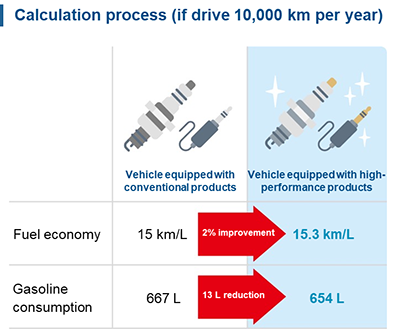
In July 2020, Our Group announced its support for the Task Force on Climate-related Financial Disclosures (TCFD) recommendations.
We will examine the impact of climate change on our Group’s business, strategies, and finance within the company-wide risk management framework based on TCFD Recommendations, and these topics will be discussed at the Risk Management Committee and the CSR and Sustainability Committee attended by the entire board of directors. We will also promote voluntary and proactive disclosure of information in accordance with the recommendations.
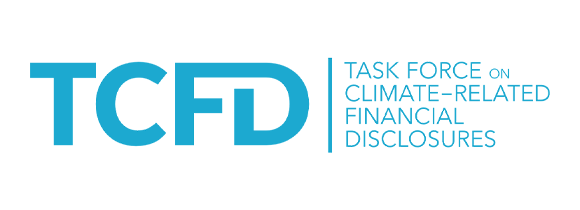
Our Group aims to realize a carbon-neutral future together with local communities, and is actively promoting the reduction of CO₂ emissions and the introduction of renewable energy at each of its business locations.
In February 2025, NTK Ceramics signed a partnership agreement with Iijima Town in Kamiina-gun, Nagano Prefecture, where its production facilities are located, to promote carbon neutrality. Iijima Town issued its "Iijima Town Carbon Neutrality Declaration" in October 2022, aiming for virtually zero carbon dioxide (CO₂) emissions by 2050. NTK Ceramics will contribute to advancing initiatives in the industrial sector to achieve carbon neutrality.
To enhance our efforts to mitigate climate change, the Group supports public policies and regulations related to climate change, and participates in the following organizations and initiatives: